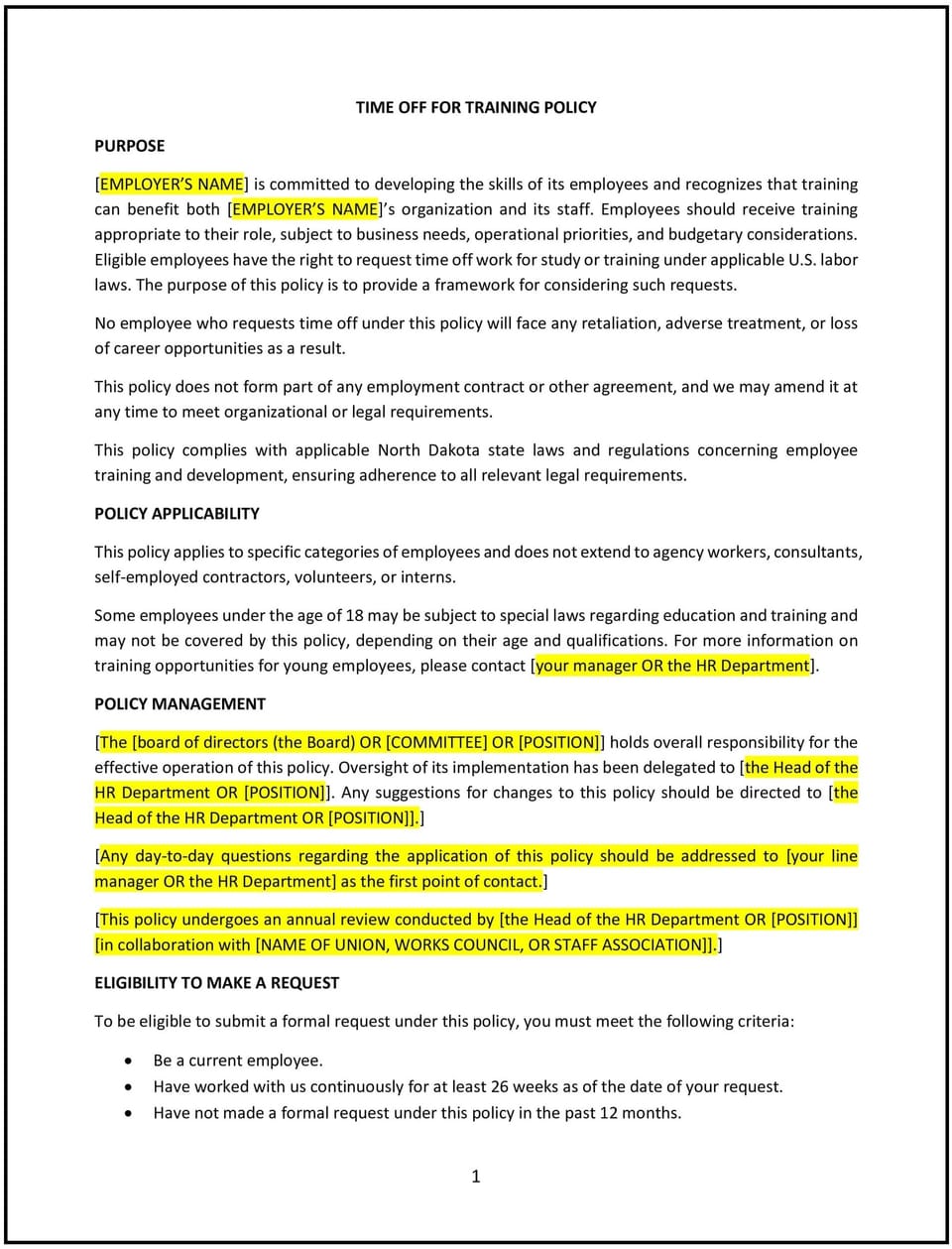Time off for training policy (North Dakota): Free template

Time off for training policy (North Dakota)
This time off for training policy is designed to help North Dakota businesses support employee development by providing time off for professional training, certifications, or skill-building activities. It outlines procedures for requesting leave, eligibility, and compensation during training.
By adopting this policy, businesses can enhance employee skills, improve performance, and foster a culture of continuous learning.
How to use this time off for training policy (North Dakota)
- Define training activities: Clearly explain what qualifies for training leave, such as workshops, certifications, or skill-building courses.
- Establish eligibility: Specify which employees are eligible for training leave, such as full-time or part-time staff.
- Outline request procedures: Provide steps for employees to request time off for training, including required notice and approval processes.
- Address compensation: Clarify whether employees will be paid during their training leave, in accordance with the business’s policies.
- Set expectations: Explain how employees will apply their new skills or knowledge to their roles after training.
- Train managers: Educate supervisors on handling training leave requests and supporting employee development.
- Review and update: Assess the policy annually to strengthen alignment with evolving workplace needs and business goals.
Benefits of using this time off for training policy (North Dakota)
This policy offers several advantages for North Dakota businesses:
- Enhances skills: Provides employees with opportunities to develop new skills and knowledge, improving job performance.
- Boosts morale: Demonstrates a commitment to employee growth and development, increasing job satisfaction and loyalty.
- Improves retention: Supports career advancement, reducing turnover and attracting top talent.
- Fosters innovation: Encourages employees to bring new ideas and approaches to the workplace.
- Builds trust: Shows employees that the business values their professional growth and contributions.
Tips for using this time off for training policy (North Dakota)
- Communicate clearly: Ensure all employees understand the policy and their eligibility for training leave.
- Provide training: Educate managers on handling training leave requests and supporting employee development.
- Monitor outcomes: Track the impact of training on employee performance and business goals.
- Encourage participation: Promote training opportunities to employees and highlight their benefits.
- Update regularly: Review the policy annually to strengthen alignment with business needs.
Q: How does this policy benefit businesses?
A: It enhances employee skills, boosts morale, and improves retention by supporting professional development.
Q: Who is eligible for training leave?
A: Eligibility depends on the business’s policy, but it typically includes full-time or part-time employees.
Q: Is training leave paid or unpaid?
A: This depends on the business’s policy. Some businesses offer paid training leave, while others provide unpaid leave.
Q: How can employees apply for training leave?
A: Employees should follow the request procedures outlined in the policy, including providing notice and obtaining approval.
Q: How often should businesses review this policy?
A: Businesses should review the policy annually or as needed to strengthen alignment with evolving workplace needs and business goals.
This article contains general legal information and does not contain legal advice. Cobrief is not a law firm or a substitute for an attorney or law firm. The law is complex and changes often. For legal advice, please ask a lawyer.


